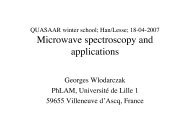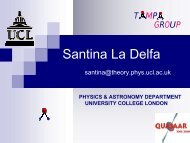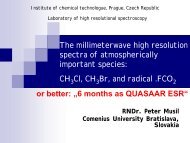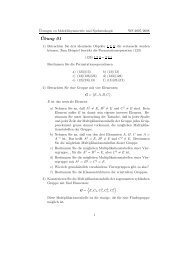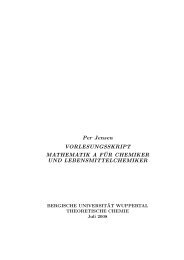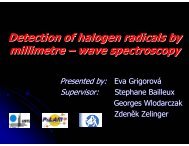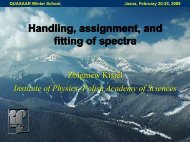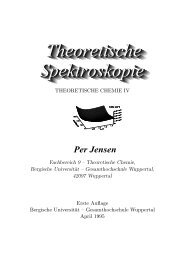Abstract book - Prof. Per Jensen, Ph.D. - Bergische Universität ...
Abstract book - Prof. Per Jensen, Ph.D. - Bergische Universität ...
Abstract book - Prof. Per Jensen, Ph.D. - Bergische Universität ...
- No tags were found...
Create successful ePaper yourself
Turn your PDF publications into a flip-book with our unique Google optimized e-Paper software.
118 Poster session, H5The Rotational Spectrum and Quantum Dynamics of the Ne-NO 2 Vander Waals ComplexG. Economides 1 , L. Dyer, B. J. Howard 21 Oxford University, UK, george.economides@spc.ox.ac.uk; 2 Oxford University, UK,brian.howard@chem.ox.ac.ukEconomides G.Dyer L.Howard B.J.The rotational spectrum of the Ne-NO 2 Van der Waals open shell complex is reported inthe frequency region 6−18 GHz. This was recorded using Fourier Transform microwavespectroscopy with a pulsed molecular beam in a supersonic jet expansion, with finalresolution of 5 kHz. An initial analysis of the spectrum was made using the structureobtained from high order ab initio calculations (MP4(SDQ) counterpoise-correctedoptimization calculations with the aug-cc-pv(D/T/Q)Z basis sets and extrapolating toCBS limit). The computational package used at this stage was Gaussian 03. Using theminimum energy geometry yield from these calculations and treating the complex as anasymmetric top, it was possible to assign 24 of the lines, corresponding to the K = 0 J =1←0, J = 2←1 and J = 3←2 transitions. However, attempting to analyse the rest of thespectrum it became clear that this model was inadequate to describe the system, aproblem not met in the complexes of NO 2 with heavier rare gases.Due to the weak nature of the bonding between the rare gas atom and the NO 2 , the latterexhibits large amplitude motion. In order to assign the rest of the observed transitions(K=±2), it was necessary to perform a quantum dynamical calculation. Thus, thecomplete counterpoise-corrected potential energy surface of the complex on its groundstate was calculated using the RCCSD(T) method and the aug-cc-pV(D/T)Z basis sets(extrapolated to CBS limit), varying the angles θ every 20° and the angle χ every 30°.The radial variable R, which is the distance between the Ne atom and the centre of massof NO 2 , was varied from 2.8 Ǻ to 3.8 Ǻ every 0.1 Ǻ. The computational package usedwas Gaussian 09. This potential was then fitted to both a global fit of all the variablesand to two functions distinguished by the Born-Oppenheimer Angular RadialSeparation. The fitting was performed by the use of MATLAB and MATHEMATICApackages. Two MATHEMATICA programs were written, one to perform the quantumdynamics and one to predict the fine and hyperfine splitting of the energy levels due tothe nuclear and electron spin angular momenta.The rotational constants, effective minimum geometry, binding energy, zero pointenergy, centrifugal constants as well as the hyperfine constants for the complex weredetermined and compared with those of similar species: Ar-NO 2 1 , Kr-NO 2 2 and Xe-NO 2 3 .References[1] R. J. Low, M. D. Brookes, C. J. Whitham, B. J. Howard, J. Chem. <strong>Ph</strong>ys. 105, 6756,1996[2] S. Blanco, C. J. Whitham, H. Quian, B. J. Howard, <strong>Ph</strong>ys. Chem. Chem. <strong>Ph</strong>ys., 2001,3, 3895 – 3900[3] C. J. Whitham, R. J. Low, B. J. Howard, Chem. <strong>Ph</strong>ys. Lett. 286 (1998) 408 − 414




